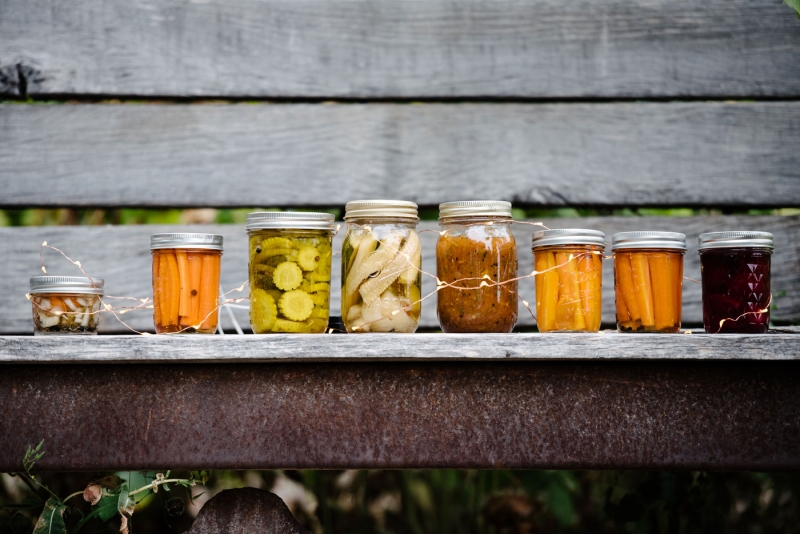In Utah most fruits and vegetables cannot be grown year-round. However, storing food during the winter months from our gardens or from farmers markets allows us to maintain our commitment to local food all year long. Before the advent of refrigerators and the long distance transportation system, food storage techniques were essential.
People native to this region and early pioneers were masters at subsisting on locally harvested food and were skilled food preservers. Today, many of us have forgotten these skills. But by learning how to preserve our own fresh, healthy food, we can save money and eat healthier at the same time!
Food can be preserved in a variety of ways specific to the type of fruits or vegetables one is trying to store. The main food storage methods include: freezing, dehydrating, canning, cold storage, jamming and pickling. We will discuss the first four methods here, and to learn more, please check out the resources list at the end of this article.
Freezing
Freezing is likely the most common food storage technique utilized today. Most produce requires blanching (heating vegetables in boiling water or with steam, then submerging them in ice water for cooling) before they are frozen. Blanching helps preserve color and nutrients in frozen veggies and blanching time is specific to each type. A general rule is that when produce color intensifies, it is ready to be removed from the boiling water or steam. Peppers, tomatoes, onions and most fruits do not require blanching.
Winter squash should be cooked and then frozen. Fresh herbs can be chopped then frozen with water in ice-cube trays. You can also make pesto ahead of time and freeze it in ice-cube trays. After the ice-cube tray is frozen, remove the cubes and place them in a labeled freezer bag or airtight container. For tomatoes, cook into a sauce and then freeze.
Some fruits will darken when frozen. This can be prevented by dipping fruit into a ascorbic acid syrup (or lemon juice) before freezing.
Frozen produce will generally last at least 12 months and often times much longer. Always use airtight containers to prevent moisture loss and freezer burn. When freezing produce, like all other food storage methods, always save the best produce for storing, as it will keep longer and not go bad as quickly.
Pros to freezing are that it is simple and retains much of the flavor and vitamins. The drawbacks are that freezing is energy-intensive and in when the power goes out, for example during a storm, food will spoil if it gets warm. (During a power outage, keep your refrigerator and freezer at its coldest by not opening the door unless absolutely necessary.)
Dehydration
Drying food has some great advantages. Dried foods take up less space than frozen, canned or stored produce. They are ideal for snacks, or to take on camping or hiking trips.
Also, if drying in the sun, this method uses the least amount of energy. Similar to other preservation methods, dehydrating fruits and vegetables slows down the chemical and micro-biotic decomposition processes. Perhaps the oldest food preservation technique, dehydration can be accomplished using electric or solar powered food dehydrators, ovens and most simply by laying food out to dry under the sun. Using electric dehydrators is the fastest method of drying vegetables and fruits, taking about six hours.
Apricots, peaches, grapes, plums, apples, cherries, currents, bananas, mangos, peppers, tomatoes and shell peas and beans are among the most popular fruits and vegetables to dry. Most veggies need to be blanched (above) before they are dried and you may want to dip fruit in an ascorbic acid syrup (or lemon juice) to preserve color.
Chop the produce in uniform pieces for uniform drying rates. Fruits and veggies can be eaten in their dry state (ex. raisins, apricots) or rehydrated for cooking (ex. peppers). Dehydrated food will store from 6 to 32 months depending on the type. Freeze dried produce for a few days to kill any bugs or larva than may have hidden in your fruit.
Shell varieties of beans and peas are east to dry without any special equipment. Let pods dry out and become brown on the plants. Pick pods before they crack and beans (or peas) fall out. If it looks like frost is imminent, pick the peas and beans and finish drying them off the plant.
Freeze for 2-3 days to assure all bugs and their larva have been killed. Then store them in a jar in a cool, dry place for up to 1 year.
Other simply drying methods that you can try if you don’t have an electric dehydrator include:
- Laying out apricots or blanched tomatoes on a cheesecloth stretched inside a wooden frame, and then covered with an additional layer of cheesecloth to protect against bugs (drying will take 2-4 days);
- Hanging herbs and hot peppers to dry from their stems outside in the shade or in a room with good circulation. Store peppers in dry conditions for 6+ months.
Canning
Tomatoes, tomato sauces, salsas, peppers, peaches and pears are the most commonly canned foods. Out of all the food preservation techniques, canning requires the most equipment and has the most particular process.
There are two main methods for canning: water bath canning for high acidity foods (ph of 4.6 or lower) and pressure canning for low acidity foods. Boiling the jars both pressure seals and kills bacteria. Both methods of canning require large pots (or a pressure canner for the latter), canning jars, rings and lids, and jar lifter tongs.
For low acidity foods, a temperature of 240 degrees F (well above boiling) is required to kill any dangerous microorganisms.
It's important that you follow the safety precautions when canning to prevent foodborne disease. However, when done properly, canning provides delicious home grown food all winter long! The USDA has an extensive resource on food safety and home canning.
Store canned foods at 50-70 degrees F in a dry and dark place.
Cold Storage
Much of the produce from your garden will keep for quite a long time if harvested at the right time and stored correctly. In most instances, do not wash the fruits and vegetables before you store them. Store only mature, damage free vegetables.
The following list is taken from Home Food Systems , edited by Roger B. Yepsen, Jr. (Rodale Press, Emmaus, Pennsylvania, 1981).
- Apples. Store tree-ripened fruit, and leave stems on. Keep in shallow baskets or boxes, since fruit bruise easily. Requirements: 32 to 40 degrees F, 80–90% humidity. Life: 4 to 6 months.
- Beets. Pick mature vegetables before first killing frost. Pack in layers of damp sawdust or sand. Requirements: 32-40 degrees F, 90-95% humidity. Life: 4-6 months.
- Cabbage. Pick firm, solid heads, and trim off loose outer leaves. Place heads on shelves, string them up by the roots, or wrap in newspaper and store in boxes or bins. (Beware: cabbage emits a strong odor during storage, so you may want to keep it from other fruits and vegetables.) Requirements: 32 – 40 degrees F, 80-90% humidity. Life: 2 to 4 months.
- Cantaloupe. Pick just before maturity. (Fully ripe cantaloupe will keep only 1-2 weeks.) Store on shelves or in boxes or baskets. Requirements: 40 to 50 degrees F, 85-95% humidity. Life: 4-6 weeks.
- Carrots. Dig before any hard freezes. Store in cartons of sawdust, sand, or leaves. Requirements: 32-40 degrees F, 90-95% humidity. Life: 6 to 8 months.
- Garlic. After curing (clip leaves off and leave out of direct sun 5-7 days), store in paper bags, or braid into strings and hang in a cool, dry place. Requirements: 35-40 degrees F, 60-70% humidity. Life: 6 to 8 months.
- Grapes. Store only fall ripening grapes. Keep bunches in trays or baskets one layer deep, or hang in bunches. Requirements: 32 to 40 degrees F, 80 to 90% humidity. Life: 1 to 2 months.
- Onions. After curing (leave in sun 5-7 days), remove tops and store in bins or string bags, or braid and hang. Requirements: 35-40 degrees F, 60-70% humidity. Life: 4 to 6 months.
- Parsnips. Mulch in ground or store in damp sawdust, sand, or leaves. Requirements: 32-40 degrees F, 90-95% humidity. Life: 4 to 6 months.
- Pears. Pick mature—but not fully ripe---pears. Wrap individually and store in shallow layers in boxes or baskets. Requirements: 32 to 40 degrees F, 80-90% humidity. Life: 2 to 3 months.
- Potatoes, white. Late potatoes store best. After curing (expose to 60-75 degree air for 7-10 days out of sun), pack in baskets or boxes. Don’t store near apples, which give off an odorless gas (a plant hormone called ethylene) that promotes sprouting. Requirements: 32-40 degrees F, 80-90% humidity.; Life: 4 to 6 months.
- Pumpkins. After curing (expose to sun and air 10-14 days), place on shelves or in boxes. Requirements: 50-60 degrees F, 60-70% humidity. Life: 4-6 months.
- Squash, winter. After curing (expose to sun and air for 10-14 days), pack on shelves or in boxes. Requirements: 50-60 degrees F, 60-70% humidity. Life: 4-6 months.
- Tomatoes, green. Pick mature green fruits before frost. They will gradually ripen at 55-70 degrees F. Requirements: 50-60 degrees F, 60-70% humidity. Life: 4-6 weeks.
- Turnips. Harvest before a heavy freeze. Store like carrots. Requirements: 32-40 degrees F, 90-95% humidity. Life: 2-4 months.
Following the temperature and humidity requirements is critical. Keeping things cool is essential. Select a cool spot in your basement or other unheated space which does not freeze.

